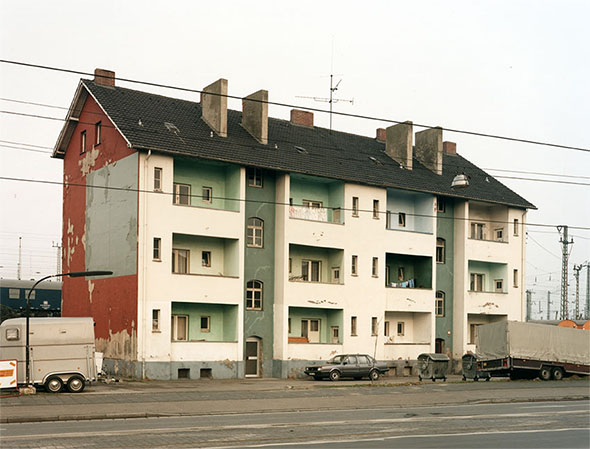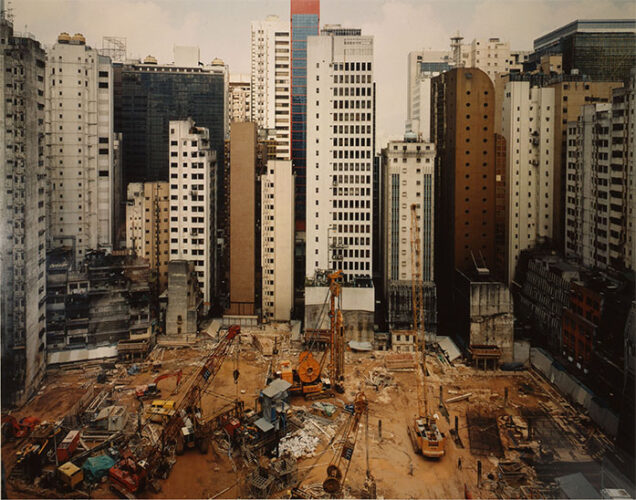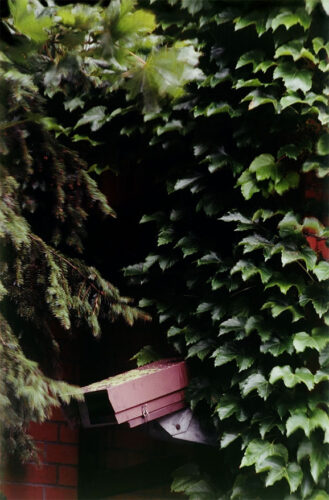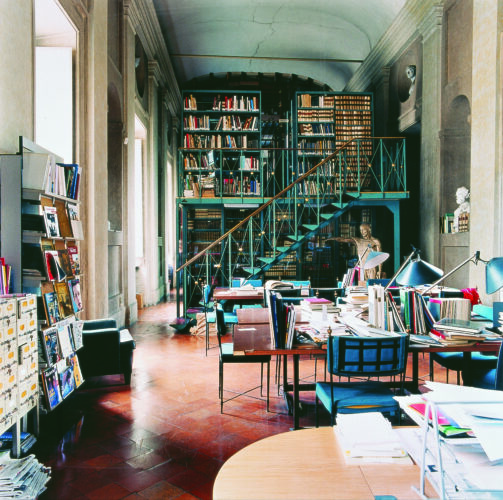EXPOSICIONES
Después de todo. Fotografía en la Colección Helga de Alvear
Eugène Atget, Bernd & Hilla Becher, Mario von Bucovich, Janos Frecot, Andreas Gursky, Candida Höfer, Axel Hütte, Thomas Ruff, Hugo Schmölz, Josef Stoffels, Cami Stone, Sasha Stone, Thomas Struth, Frank Thiel, Paul Wolff
3 jun. — 27 jul. 2025
Espacio Cultural Serrería Belga
— Madrid
Inauguración
2/6/2025 a las 11h
Comisariado por
Sandra Guimarães y María Jesús Ávila
Organiza
Ayuntamiento de Madrid, Espacio Cultural Serrería Belga, Museo de Arte Contemporáneo Helga de Alvear y PHotoESPAÑA
Horarios de la sede
Lunes cerrado
Martes a viernes
11:00–20:00
Sábado
12:00–20:00
Domingo
12:00–18:00
Sede
Espacio Cultural Serrería Belga
Alameda, 15
Entrada
Mapa
La herida abierta que dejó la I Guerra Mundial, la crisis industrial que vivió Alemania Occidental desde 1950 y que azotaría a Europa y Estados Unidos, y la reconfiguración del orden político mundial tras la caída del muro de Berlín, que habría de marcar el inicio de la sociedad contemporánea con todas sus contradicciones y conflictos, simbolizan algunos de esos momentos que en sus respectivas épocas han representado el fin de algo, el después de todo.
De cada uno de estos tres tiempos históricos poseemos una imagen, construida por la fotografía y que está representada en los fondos de la Colección Helga de Alvear, siempre abrumadores. El inicio lo marcan los autores de la Nueva objetividad de los años 20 y 30, precedidos por Eugène Atget, quienes prescindieron de cualquier atisbo de optimismo y abandonaron todo rastro de subjetivismo y pictorialismo para representar el período de entreguerras con precisión técnica y exactitud formal. Al tiempo que abrían el debate sobre la veracidad de la fotografía.
La siguiente parada se inicia en 1959, año en que Bernd y Hilla Becher comenzaron el titánico inventario de edificios y estructuras industriales marcados con la inminencia de su propia muerte; constituyendo la huella de un tiempo histórico desde el mismo instante en que son atrapados por el objetivo. Un archivo melancólico de tipologías, series y sistemas –que habían de favorecer su entrada en el mundo del arte de la mano de conceptuales y minimalistas–, conformados con un método preciso e imperturbable en el tiempo. Documentos de una crisis industrial y económica, pero sobre todo social, a pesar de o a causa de la deshumanización de que es objeto el registro de estas “esculturas anónimas”.
Por último, ese nuevo tiempo que los alumnos de los Becher representaron, tornando explícito el conflicto entre la memoria y el futuro que se conceptualiza a través de sus edificios, interiores y fachadas, y de su espacio urbano, desierto o agitado por las relaciones sociales que en él se establecen. Una diversidad de singularidades arropadas por una designación, la Escuela de Düsseldorf, en la que prosigue imparable el deseo de inventariar. Ya no bajo la premisa del documento y la objetividad, sino asumiendo totalmente la naturaleza de construcción que distinguirá a la fotografía, su naturaleza de imagen. Procesos de distanciamiento, deshumanización o ensimismamiento son puestos en práctica junto a operaciones de apropiación, producción o manipulación digital, dejando a la fotografía suspendida entre la más radical objetividad y la ficción. Las imágenes de Höfer, Struth, Gursky, Hütte y Ruff cierran con la representación de un tiempo que se destruye y renace incesantemente a través de su arquitectura. Un ritmo tan rápido y nuevo que no deja lugar a la ruina, únicamente a su imagen transitoria conservada en el objetivo de Thiel. Ruina enfrentada a su reverso, la construcción de una nueva identidad y un nuevo tiempo histórico, tan complejos como la acumulación de detalles que las imágenes recogen.
En esta selección quedan a un lado retratos y paisajes, para centrar la exposición en el espacio urbano, sus edificios y sus interiores, aprovechando el contexto que la Serrería Belga nos proporciona. Un espacio que es, en sí mismo, un ejemplo magnífico de espacio industrial que acumula estratos de historia y sobrevive a partir de su reconversión como espacio cultural.
Comisarias: Sandra Guimarães y María Jesús Ávila
Artistas: Eugène Atget, Bernd & Hilla Becher, Mario von Bucovich, Janos Frecot, Hein Gorny, Andreas Gursky, Candida Höfer, Axel Hütte, Thomas Ruff, Hugo Schmölz, Josef Stoffels, Cami Stone, Sasha Stone, Thomas Struth, Frank Thiel, Paul Wolff.
The open wound left by the First World War, the industrial crisis experienced by West Germany from 1950—which would later impact Europe and the United States—and the reconfiguration of the global political order after the fall of the Berlin Wall, which marked the beginning of contemporary society with all its contradictions and conflicts, symbolize key moments that, in their respective eras, have represented the end of something—what comes after everything.
From each of these three historical periods, we possess an image, constructed through photography and represented in the holdings of the Helga de Alvear Collection, always overwhelming. It begins with the authors of New Objectivity from the 1920s and 30s, preceded by Eugène Atget, who dismissed any hint of optimism and abandoned all traces of subjectivism and pictorialism to portray the interwar period with technical precision and formal accuracy—while simultaneously opening the debate on the truthfulness of photography.
The next stop begins in 1959, the year Bernd and Hilla Becher started their monumental inventory of buildings and industrial structures, marked by the imminence of their own disappearance; forming the imprint of a historical time from the very moment they are captured by the lens. A melancholic archive of typologies, series, and systems—which would later facilitate their entry into the art world through conceptual and minimalist movements—constructed with a precise method that remains undisturbed over time. Documents of an industrial and economic crisis, but above all social, despite—or perhaps because of—the dehumanization involved in recording these “anonymous sculptures.”
Finally, the new era depicted by the Bechers’ students, making explicit the conflict between memory and future as conceptualized through their buildings, interiors, façades, and urban space, whether deserted or stirred by the social relations that unfold within. A diversity of singularities gathered under a single designation: the Düsseldorf School, where the urge to inventory continues unstoppably—not under the premise of documentation and objectivity anymore, but by fully embracing the constructed nature that characterizes photography, its very image-nature. Processes of distancing, dehumanization, or introspection are applied alongside acts of appropriation, production, or digital manipulation, leaving photography suspended between radical objectivity and the idea of fiction. The images of Höfer, Struth, Gursky, Hütte, and Ruff conclude with the portrayal of a time that is endlessly destroyed and reborn through its architecture. A rhythm so fast and novel that it leaves no room for ruin, only for its transitory image, preserved through Thiel’s lens. A ruin faced with its inverse: the construction of a new identity and a new historical period, as complex as the accumulation of details captured by the images.
This selection sets aside portraits and landscapes, focusing the exhibition on urban space, its buildings, and interiors, taking full advantage of the context provided by the Serrería Belga. A space that is, in itself, a magnificent example of industrial architecture, layered with historical strata, and now surviving thanks to its transformation into a cultural space.
Curators: Sandra Guimarães and María Jesús Ávila
Artists: Eugène Atget, Bernd & Hilla Becher, Mario von Bucovich, Janos Frecot, Hein Gorny, Andreas Gursky, Candida Höfer, Axel Hütte, Thomas Ruff, Hugo Schmölz, Josef Stoffels, Cami Stone, Sasha Stone, Thomas Struth, Frank Thiel, Paul Wolff.







